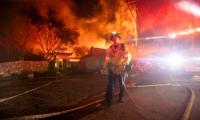LONDON: The reproduction number, or R value, of coronavirus has fallen below one for the first time since July and is now estimated to be between 0.7 and 0.9 across the UK.
In a sign that lockdown restrictions are having an impact and the epidemic is shrinking, scientists advising the government gave their most optimistic outlook for the R number since cases fell last summer. It comes as new data from the Office for National Statistics shows a drop in infections, with around one in 80 people in private households in England having Covid-19 between January 31 and February 6, the equivalent of 695,400 people.
This is down from around one in 65 people for the period January 24 to 30. The data is based on swab results from people with and without symptoms. On February 9, the latest date for which figures are available, the number of patients in hospital with Covid-19 in the UK stood at 25,621.
This is down 35 per cent from a peak of 39,236 on January 18, and is the lowest number since December 29. But while scientists advising the government believe cases of Covid-19 are dropping at a decent pace across England, they have warned that infection levels remain high.
Prime Minister Boris Johnson is facing calls from Tory sceptics to ease the lockdown once the pressure on the NHS eases and deaths drop. But scientists argue that case numbers are still too high for a significant loosening of restrictions.
They believe that only by driving case numbers to much lower levels can NHS Test and Trace and surge testing work properly. With low case numbers, clusters of cases can be identified more easily and new mutations to the virus can be picked up, one government scientific adviser said.
They argued that loosening restrictions when cases are low means there is less chance of R going above one, which leads to exponential growth of the virus, and this creates a quicker path back to normal life.
The current halving time of the virus (the time it takes to the number of new infections to halve in size) is thought to be at around 14 to 17 days. Scientific advisers believe that if this continues, aided by the rollout of vaccines, then low case numbers can be achieved in the next two to three months.
Meanwhile, NHS England has said people aged 65 to 69 can now have a Covid-19 vaccine in England if GPs have done all they can to reach those at higher risk.
Some parts of England have already begun vaccinating the over-65s with their first dose after they reached everyone in the top four priority groups, including the over-70s and care home residents, who wanted a jab.
Nottinghamshire Clinical Commissioning Group is among those issuing invites, while in Shropshire, Coventry, York and Hampshire some vaccines have been given already. NHS England said regions could now move on to people aged 65 and over if every effort has been made to contact and vaccinate those in groups one to four, and if there are supplies.
Chairman Senator Farooq Hamid Naek presided over committee at Parliament House on Wednesday
Spox says govt has played a mediatory role in this agreement, and process of disarmament is in progress
UN's role is to support govts and societies but world has become very complex and there is no easy solution, says Afke...
Meeting highlights ongoing efforts to enhance diplomatic relations between Pakistan and UAE
Minister says task force is finalising recommendations, report will be submitted to PM in next two weeks
Sindh CM and governor accompanied prime minister to residence of Sharjeel Memon







